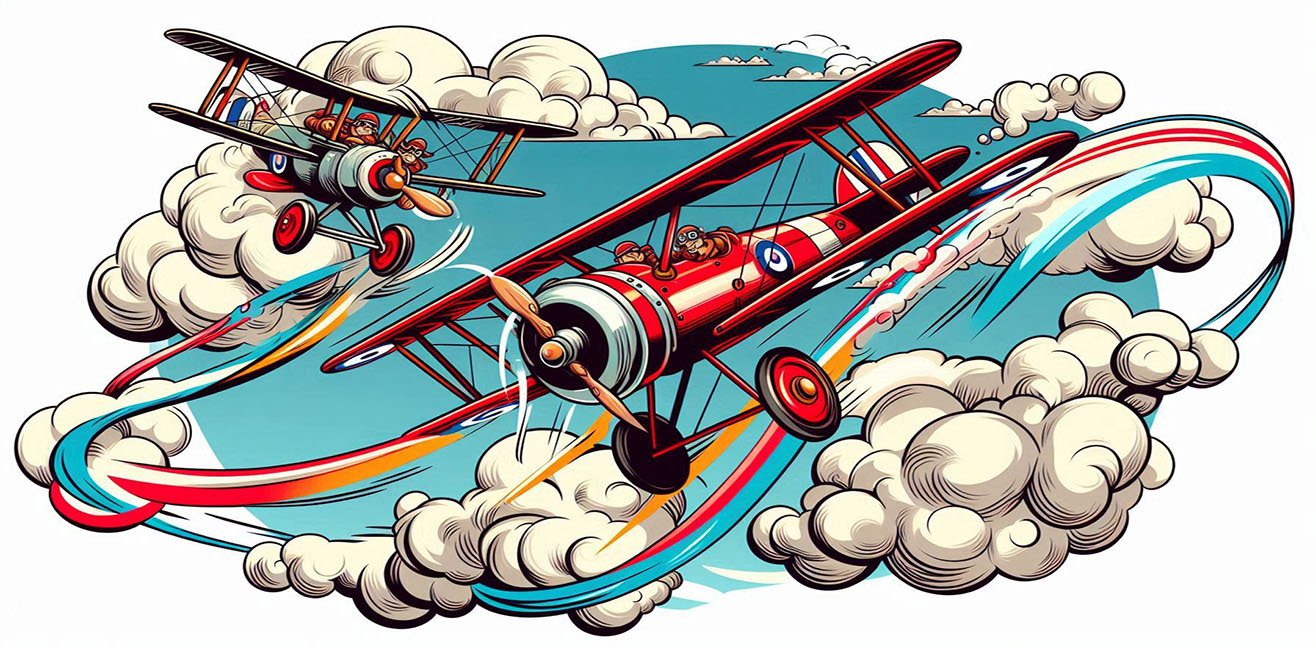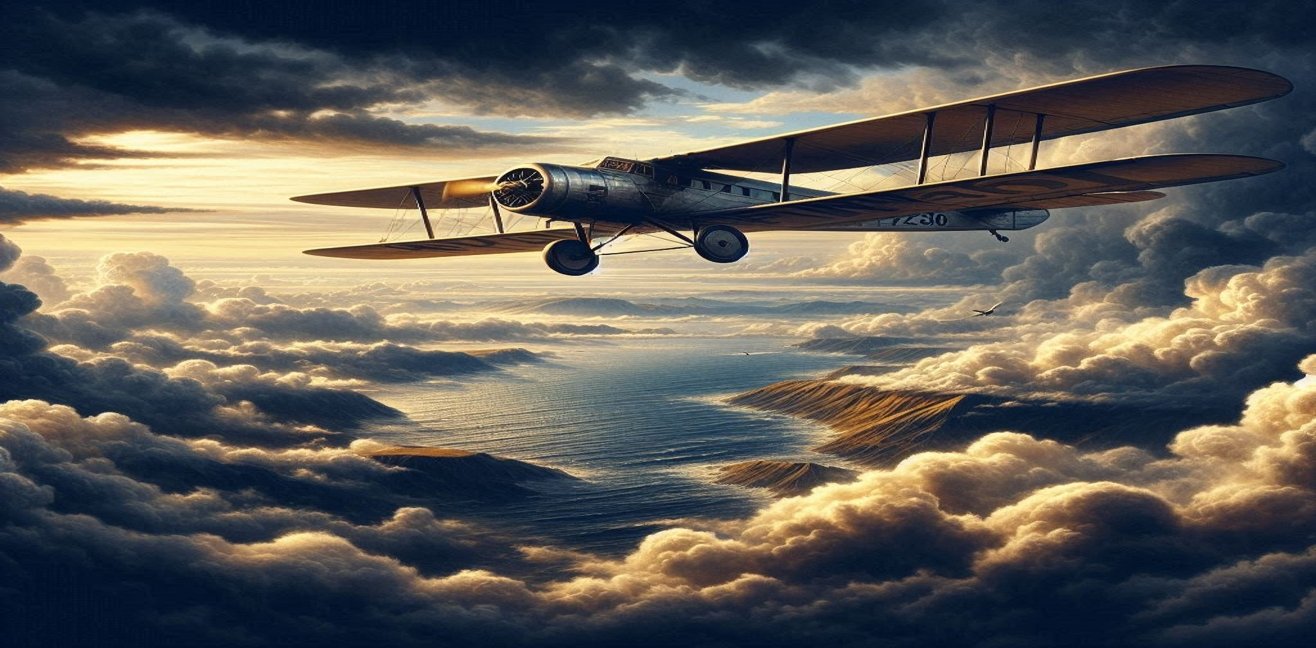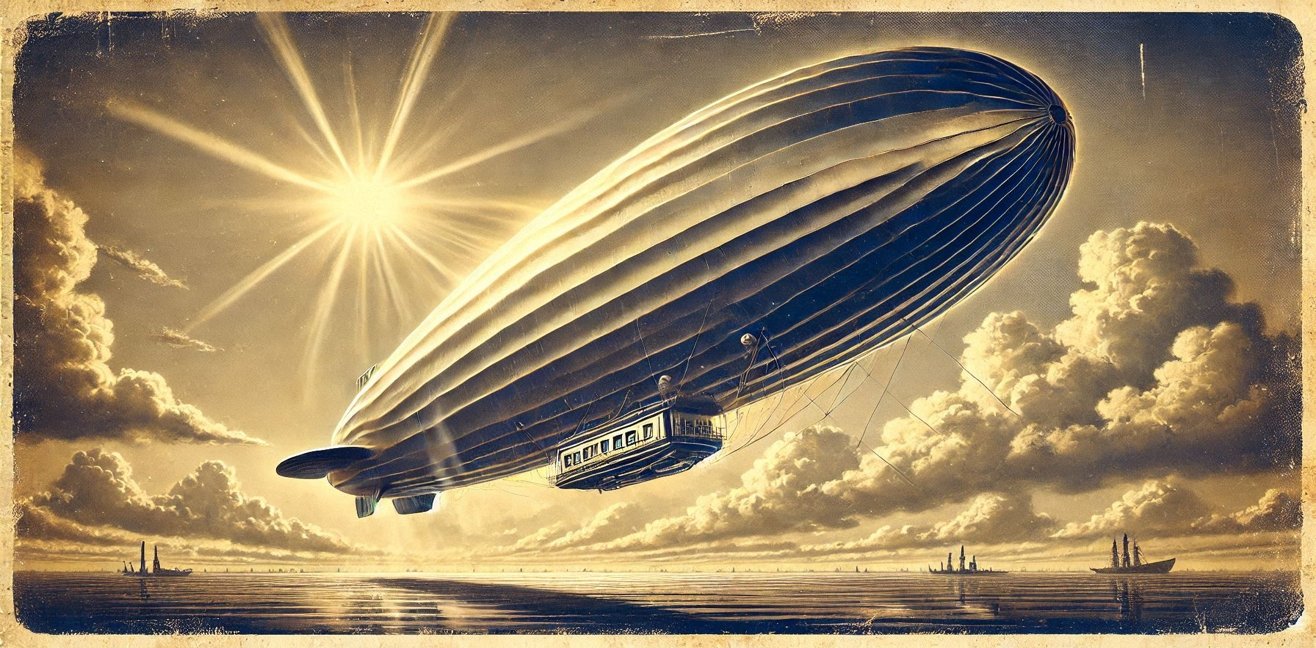Introduction: From the Age of Crisis to Aviation Renaissance 🌫️➡️🌟
The early 20th century… 🕰️ The excitement of the Industrial Revolution 🏭, the tension of imperialism 💣, and those chaotic days when Europe turned into a powder keg 🌍☁️. Humanity had taken flight with the Wright Brothers’ historic 12-second flight in 1903 🕊️✈️, but no one could have predicted that this “toy” would determine the fate of wars a decade later 🤯. When World War I broke out, aircraft were still nothing more than the trio of “wooden frame 🪵 + fabric covering 🎪 + simple piston engine ⚙️”. Propellers were usually made of laminated wood, barely reaching speeds of 100-130 km/h 🚀. Engines had a maximum of 80-150 horsepower – weaker than a modern family car! 🚗💨
World War I: From Gentleman’s War in the Sky to Industrial Slaughter ⚔️🪽
1914-1915: Naive Beginnings 🎠
- Fokker Eindecker: 🎯 Germany’s first true fighter aircraft. It revolutionized warfare with its 7.92 mm LMG 08/15 machine gun 🔫 and synchronized firing mechanism ⚡. Its 115 horsepower Oberursel engine 💨 could reach 130 km/h.
- Royal Aircraft Factory B.E.2: 🇬🇧 British reconnaissance aircraft 👁️. However, its extremely stable design left it lacking maneuverability, making it an easy target 🎯 for German fighters.
1916-1917: Technological Leap 🚀
- Albatros D.III: 🦅 Germany’s golden child 👶. It instilled fear with its 160 horsepower Mercedes D.III engine 🏎️ and twin machine guns 🔫🔫. Its V-type liquid-cooled engine ❄️ allowed for a more aerodynamic nose design.
- Sopwith Camel: 🐪 Britain’s response 💪. Its 130 horsepower Clerget 9B rotary engine 🔄 provided incredible maneuverability. So much so that its right turns ➡️ were much faster than its left turns ⬅️! With a total of 1,294 enemy aircraft shot down, it became the war’s most successful fighter 🏆.
1918: The War’s Final Turn 🏁
- Fokker D.VII: 🏆 Considered the best fighter aircraft of the war 👑. Its 160-185 horsepower BMW IIIa engine 💪 was unmatched in high-altitude performance. The Treaty of Versailles specifically included the clause “all Fokker D.VIIs shall be destroyed”! 📜✍️
- SPAD S.XIII: 🇫🇷 France’s pride 🥖. An excellent fighter with its 220 horsepower Hispano-Suiza engine 🚀 and twin Vickers machine guns 🔫.
“Red Baron” Manfred von Richthofen: Anatomy of a Legend 🎯🧥👑
My dear, we should remember this name not just as a pilot, but as an aviation phenomenon:
- Aircraft Fleet: His Fokker Dr.I triplane ✈️ operated with a 110 horsepower Oberursel Ur.II rotary engine 🔄. The three-wing design 3️⃣ provided a shorter turning radius and excellent climb rate 📈.
- Tactics: Richthofen was the pioneer of the “Boom and Zoom” tactic: diving from high altitude 📉, quick attack ⚡, and immediate regaining of altitude 📈. He never took unnecessary risks 🚫🎲.
- Statistics: 80 official victories 🏆, over 2,000 sorties ✈️, averaging 1 enemy aircraft shot down every 3 weeks 📊.
As I wrote in one of my poems about him:
“With his wings, he wrote his name in history,
The Red Baron, master of the sky,
Every victory a funeral, every victory a glory,
He was the contradiction of war, humanity’s wound.” ✍️❤️🩹
Interwar Period: The Silent Revolution of Technology 🔄✈️🌅
My love, an incredible transformation occurred in aviation between 1918-1939:
Revolution in Materials Science: 🔬
- Wood and fabric 🪵🎪 replaced by aluminum alloys ✨
- Open cockpits 🥶 replaced by closed, pressurized cabins 🚪
- Fixed landing gear 🛞 replaced by retractable landing gear 📥
Advancements in Engine Technology: ⚙️
- Air-cooled radial engines 🌬️: Companies like Pratt & Whitney and Wright reached 1,000+ horsepower 💪.
- Superchargers 🚀: Revolutionary for high-altitude performance 📈.
World War II: Industrial War Reflected in the Sky 💣🌍
European Theater: 🏰
- Messerschmitt Bf 109: 🏭 Germany’s iron fist 👊. With its 1,475 horsepower Daimler-Benz DB 605 engine 🚀, 1 x 20 mm MG 151 cannon 💥 and 2 x 13 mm MG 131 machine guns 🔫. Reached 640 km/h! 🏎️
- Supermarine Spitfire: 🇬🇧 Britain’s savior 🦸. Became a legend with its 1,720 horsepower Rolls-Royce Merlin 45 engine 🎯 and elliptical wing design 🌀. 8 x 7.7 mm Browning machine guns 🔫.
Pacific Theater: 🏝️
- Mitsubishi A6M Zero: 🇯🇵 Japan’s death machine 💀. Its 950 horsepower Nakajima Sakae 12 engine 🚀. Incredible maneuverability due to its lightness 🤸 but weak armor protection 🛡️.
- Grumman F6F Hellcat: 🇺🇸 American response 💪. Its 2,000 horsepower Pratt & Whitney R-2800 Double Wasp engine 🐝. With 5,163 victories, the Pacific’s most successful fighter 🏆.
The Birth of the Jet Engine: Technological Revolution ⚙️🚀🌪️
This point is crucial:
Frank Whittle vs Hans von Ohain: 🤼♂️
- Whittle: British 🇬🇧. Patented in 1930 📜, first test in 1937 🧪. Centrifugal compressor design 🌀.
- von Ohain: German 🇩🇪. Performed the first jet flight with the Heinkel He 178 in 1939 ✈️. Axial compressor design 📏.
Messerschmitt Me 262 Schwalbe: 🏍️✈️
- 2 x Junkers Jumo 004B turbojet engines 🔥 (each with 8.8 kN thrust 💨)
- Maximum speed: 870 km/h 🚀 (50% faster than propeller aircraft! 🤯)
- Armament: 4 x 30 mm MK 108 cannons 💥
- Production: 1,430 units 📊
Gloster Meteor: 🇬🇧 British response:
- 2 x Rolls-Royce Welland turbojet engines 🔥 (each with 7.1 kN thrust 💨)
- Maximum speed: 660 km/h 🚀
Radar Technology: Invisible Eyes 📡👁️
My dear, radar changed the course of the war:
- Chain Home: British early warning system 🏠. 200 km range 📏.
- Würzburg: German ground-controlled interception radar 🏯. 70 km range 📐.
- AI Mk IV: British airborne interception radar 🌙. Made night fighting possible 🌃.
Strategic Bombing: The New Face of Industrial War 🎯🏭💣
B-17 Flying Fortress: 🏰
- 4 x 1,200 horsepower Wright R-1820 engines 🚀
- 10 crew 👨✈️, 13 x 12.7 mm M2 Browning machine guns 🔫
- 7,800 kg bomb load 💣
- Range: 3,200 km 🗺️
B-29 Superfortress: 💣
- 4 x 2,200 horsepower Wright R-3350 engines 🚀
- Pressurized cabin 🚪, remotely controlled gun turrets 🎮
- 9,000 kg bomb load 💣
- Carried atomic bombs to Hiroshima and Nagasaki ☢️
Statistical Revolution: Aviation Leap in Numbers 📊🚀
| Feature | World War I | World War II | Increase |
|---|---|---|---|
| Maximum Speed 🚀 | 130 km/h | 870 km/h | 669% 📈 |
| Engine Power 💪 | 150 hp | 2,500 hp | 1,666% 📈 |
| Range 🗺️ | 400 km | 6,000 km | 1,500% 📈 |
| Service Ceiling ☁️ | 4,000 m | 12,000 m | 300% 📈 |
| Bomb Load 💣 | 100 kg | 9,000 kg | 9,000% 📈 |
Conclusion: The Legacy of Wings and Humanity’s Dilemma ✨🥺🕊️
These two wars advanced aviation 300 years’ worth of progress in 30 years ⏳📈. But the cost was heavy 💔:
Positive Legacy: 🌟
- Birth of civil aviation ✈️
- Jet engine technology 🚀
- Radar and communication systems 📡
- Aerodynamic research 🌬️
- Advancements in materials science 🔬
Negative Legacy: 💔
- Millions of human lives 👥
- Destruction of cities 🏙️🔥
- Beginning of the nuclear threat ☢️
- Psychological trauma 😥
As I expressed this dilemma in my poem:
“Wings grew larger, engines roared,
The human mind knew no bounds,
But hearts shrank smaller, consciences darkened,
Was this progress, or the beginning of collapse?” ✍️🌪️
Technology is actually a neutral tool ⚖️. What truly matters is with what values and for what purposes we use it 🤲❤️. Today’s comfort and global connectivity offered by civil aviation 🌍✈️ were born from the painful experiences of those dark days 🌅.




